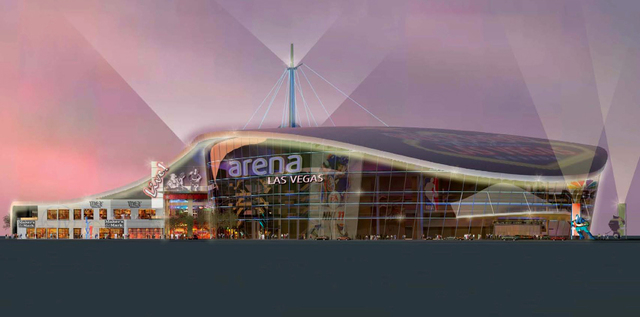Officials offer views on two contrasting Las Vegas stadium, arena plans
The Great Las Vegas Arena Race featured a scene Monday rarely seen: Rick Arpin and Port Telles sitting side by side on a sports venue policy panel, representing the two front-running arena proposals in Las Vegas.
Arpin is arena point man for MGM Resorts International, partnering with entertainment company AEG on a $350 million arena project behind New York-New York on the Strip.
Telles is development director for The Cordish Cos., partnering with Las Vegas on a $390 million downtown arena.
As panel discussions go, Arpin, Telles and two other speakers — UNLV acting President Don Snyder and policy analyst Jeremy Aguero — didn’t reveal any blockbuster news at the “Hashtags and Headlines” luncheon at Texas Station presented by the Las Vegas Review-Journal.
The most prominent item was Telles telling 60 luncheon attendees that Cordish recently signed a confidentiality agreement with an unnamed company that has the financial resources to bring a National Basketball Association or National Hockey League team to the city-Cordish arena proposed for Symphony Park.
But the overriding theme that emerged was how fundamentally distinct the business models are for the two arena proposals.
The MGM-AEG arena is privately financed, scheduled to open in mid-2016 without an NBA or NHL tenant and is an investment in offering an upscale venue experience to millions of visitors staying at MGM hotel-casinos in that immediate area. Meanwhile, the city-Cordish arena is seeking public dollars to build and relies on having a major-league basketball or hockey team serving as a tenant.
Arpin enthusiastically told the lunch guests, “We’re building that sucker.”
Telles was not in a position to match that guarantee because the downtown arena needs a big-league team. But he did say both arenas could financially co-exist and supported his arena proposal by explaining new sports venues built in downtown Washington, D.C.; Los Angeles; and San Diego, for example, spur other revenue-generating real estate development.
“Our primary focus is to bring professional sports to Las Vegas,” Telles said.
But Arpin said securing an NBA or NHL team is no quick nor inexpensive challenge.
Although Arpin said the MGM-AEG 19,500-seat arena will be built to NBA and NHL specs, he noted it costs in the “high nine figures” to draw an expansion or relocated major-league sports franchise.
“We’re not going to wait around” for a team, he said. “Teams will take from an economic model. But we want to be ready. We would entertain those discussions.”
Aguero, principal analyst of Las Vegas-based Applied Analysis, a fiscal and policy research firm, cautioned those who believe a new big-league team would deliver a major windfall of new net income to the Las Vegas economy. He described the amount of new net income as “somewhat limited.”
Major-league teams usually seek a healthy bite of their venues’ revenue streams, such as parking, signs, naming rights and food and beverage.
Meanwhile, Snyder, the veteran former banking and gaming executive leading UNLV’s push for an on-campus stadium, said it’s up to Las Vegas’ resort industry to weigh in on whether the stadium should be domed.
An 11-member UNLV stadium board, which includes representatives of five of the six biggest Las Vegas hotel-casino companies, has hired a consultant to analyze the market and come up with stadium options.
Aguero said the Las Vegas market would be hurt without a new stadium.
“The fact we haven’t built a stadium is maddening to me,” he said.
The UNLV stadium board is required to give a stadium feasibility report to the state Legislature in the fall. Its next meeting is at noon Thursday at the UNLV Foundations Building at 4505 Maryland Parkway.
Contact reporter Alan Snel at asnel@reviewjournal.com or 702-387-5273. Follow @BicycleManSnel on Twitter.



























